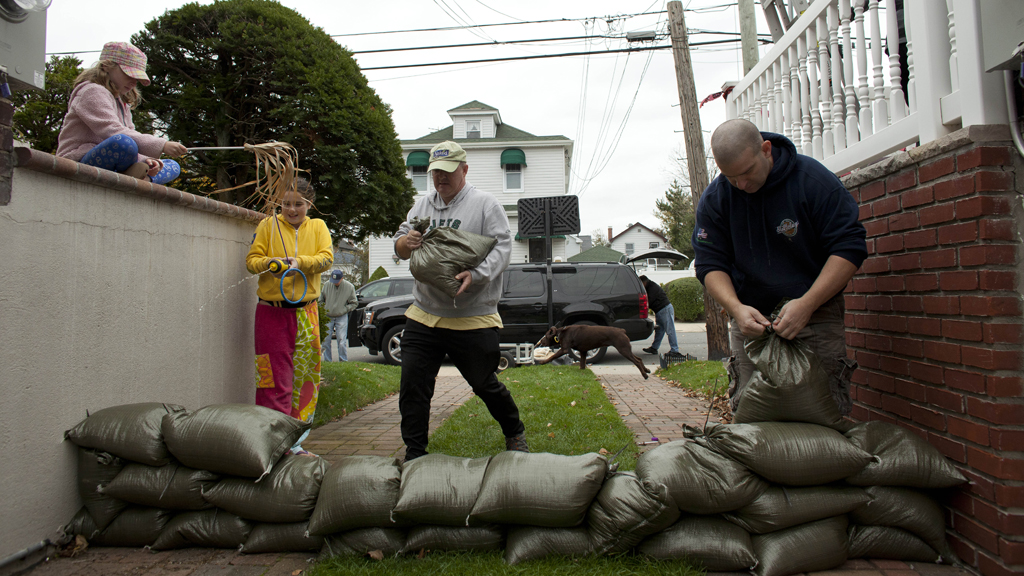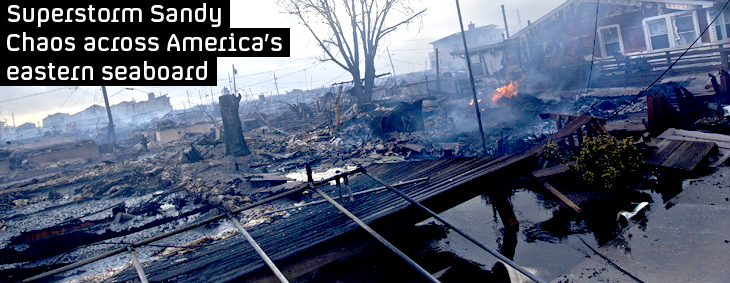‘Frankenstorm’ forces 60m to evacuate, 3m without power
Super storm Sandy ripped through 11 states closing subways, schools and stock exchanges, leaving floodwater in Atlantic City, collapsed buildings in New York and downed power lines.
- Chapters
- descriptions off, selected
- subtitles off, selected
- captions settings, opens captions settings dialog
- captions off, selected
This is a modal window.
This is a modal window. This modal can be closed by pressing the Escape key or activating the close button.
Millions of east coast residents were expected to wake up on Tuesday to power outages, flooded subways, blocked roads and fallen trees. Thousands of planes were grounded in the US. At least 45 UK flights to the east coast did not depart.
While there were no immediate confirmations of casualties, one man was reportedly killed by falling trees in Queens, New York and another in rising floodwaters in neighbouring New Jersey.
Channel 4 News Washington Correspondent Matt Frei drove over closed bridges into Manhattan early Monday evening as the hurricane closed in. He did not realise the danger.
“Barriers had been blown away by #sandy,” he tweeted. “Cops not getting out of their cars.”
‘Steer clear of windows’
The hurricane strengthened as it headed for land with winds at 90 mph reaching as high as 110 mph. Battery Park in lower Manhattan was under about four inches of water early last night but there were predictions it would rise to at least a foot overnight. The situation was changing by the minute.
“Stay away from windows and close the drapes if you haven’t already,” New York City Mayor Michael Bloomberg warned residents. Some 47,000 Con Ed were without power in New York and the company warned they might shut down power in lower Manhattan to prevent damage to equipment.
President Barack Obama urged people to listen to local officials. He suspended campaigning and returned to Washington to oversee the emergency response to the hurricane, which last night was downgraded to a tropical storm. Republican rival Mitt Romney curtailed political events to show respect for the storm’s potential victims.
Manhattan hit hard
Larger cities on the east coast appear to have been hard hid but with so many power cuts it was difficult to gather information. Ferocious winds and storms resulted in at least one building collapse in Chelsea, lower Manhattan. A crane was hanging perilously over a luxury building in mid-town early in the evening and a restaurant on the upper west side in the 90s collapsed, according to the New York Fire Department and local news.
Entire towns next door in New Jersey were reportedly under water and some areas were unreachable. Police said they were pulling people from trucks and trying to find stragglers on the streets to bring them to safety. It was impossible to move in Atlantic City, New Jersey, a mecca for east coast gamblers and casinos.
“There’s nowhere to go. You can’t get out of Atlantic City,” said Montgomery Dahm, owner of Tun Tavern. He said he planned to remain open to feed emergency workers and media crews looking for shelter.
Widespread property damage
There were reports of widespread destruction to properties along the east coast, including in Philadelphia, New York and Connecticut, some of the most expensive real estate in the US. Winds of 84 mph were reported in Connecticut. The state of Delaware, south of Atlantic City, reported seven inches of rain in one day.
“Hurricane Sandy is phenomenally big,” Channel 4 News Weather Reporter Liam Dutton said last night on Twitter. He said hurricane-force and tropical storm-force winds stretched 175 miles and 485 miles from the centre respectively.
State governors from Virginia to Massachusetts warned of the acute danger from the storm for residents in its path. At least 10 states had declared a state of emergency on Monday.
US stock markets closed for the first time since the 11 September 2001 attacks when New York voluntarily shut down the NYSE. Schools were cancelled up and down the east coast.
$45bn to rebuild
Sandy was forecast to cause up to US$45 in losses and damage, and lost output from the region could cost up to $10bn a day, according to a Reuters report. Insurance companies were bracing to face their largest losses on record. Even with severe damage, the economic devastation was seen to be short-term, however.
Gross domestic product in the region between New York and Washington amounts to some $2.5 trillion, Mark Zandi, chief economist at Moody’s Analytics.
Economists say some of the impact caused by businesses closing will be offset by reconstruction efforts, and point to catastrophic storms like Katrina, which devastated New Orleans but did not deal lasting damage to the national economy.
Damage caused by last year’s Hurricane Irene totalled as much as $20bn and damage from Katrina in 2005 exceeded $100bn by most accounts.
A final figure was impossible to predict as the storm appeared to be moving from the US coast north to Ontario, Canada and into the east coast.

In pictures: Preparing for Hurricane Sandy
The cost of a hurricane
The trading floors at the New York Stock Exchange are eerily quiet, their first weather-related shutdown for 27 years, which will now last into tomorrow. Major business activities have also been disrupted as banks closed down and many companies told staff to work from home.
The Department of Labour says it is working hard to make sure that the monthly jobs report comes out on time on Friday, after reports that the crucial economic data release could be delayed until after the election.
The cost of wind damage alone could reach $3bn, according to the Federal Emergency Management Agency, while meteorologist Mike Smith from AccuWeather told USA Today: “I expect the total damage (including loss to the US economy) to be worse than Katrina.” In other words, it could all cost more than $100bn in damage.
The New York governor’s office has warned that storm surges could send flood waters rising up to 11 feet along some coastal areas, as Governor Andrew Cuomo warned: “In a situation like this, you prepare for the worst, and hope for the best.”
Latest reports from the city show flooded streets in parts of Brooklyn, while a live webcam at New York harbour is providing a front-row view of the action.
Further along the coast, Connecticut’s governor Dan Malloy had an even more dire warning: “This is the most catastrophic event that we have faced and been able to plan for in any of our lifetimes.”
In New Jersey, where the eye of the storm is due to make landfall, Atlantic City is underwater and under a night-time curfew, while floodwater is also surging through the streets of Ocean City in Maryland: state officials warned it was inevitable that lives would be lost.
Out at sea, the US coastguard says 14 people who abandoned ship after the replica HMS Bounty lost power and began taking on water, off the coast of North Carolina have been safely rescued. The search continues for two crew members who are still unaccounted for.
Campaigning on hold
President Obama, treading a delicate balance between the final, crucial days of the election campaign and taking charge in a national disaster, cancelled a scheduled campaign event in Florida, heading straight for the situation room in the White House.
Switching instantly into commander-in-chief mode, he talked of long term power outages and transportation problems, but declared: “The great thing about America is we all pull together, we look out for our friends, we look out for our neighbours.”
Asked about the likely impact on the election, he was quick to quash any notion of party politics. “I’m not worried about the effect on the election,” he said. “I’m worried about the effect on families, on first responders, on the economy… the election will take care of itself next week”.
Mitt Romney, in Ohio, also announced he would be cancelling all campaign events tonight and tomorrow, out of “sensitivity” for the millions of Americans who could be in harm’s way. His campaign team in Virginia has been collecting donations to hand over to those worst affected by the storm.
Early voting has been suspended in Maryland, while Connecticut has extended its voter registration deadline until 1 November. Gallup and other polling companies are suspending their activities. In effect, though, Hurricane Sandy has frozen the election campaign in time, at a moment when it could hardly be more critical.
Hurricane Sandy in numbers:
– 375,000 evacuated in lower Manhattan and other parts of New York City
– 50,000 evacuated in Delaware
– 30,000 evacuated in Atlantic City, New Jersey
– 7,500 flights cancelled
– 800 miles of coastland expected to be affected
– 14 US Coast Guard crew members rescued off the coast of North Carolina
– 2 more crew members remain missing.
Days-long disaster
Meanwhile, officials have warned people not just to focus on the eye of the storm, devastating though that is: this is one disaster that could last for days. As yet, power companies say 45,000 people are without power, but they have warned that supplies to millions of people could be cut, while conditions will hamper recovery and rescue efforts as the heavy rains and winds move slowly across a vast area.
The latest from New York is that the main Holland and Battery tunnels will close at 2pm this afternoon. The bridges into Manhattan remain open for now, but developments are being closely monitored. Connecticut is closing its highways at lunchtime, while severe driving restrictions in Delaware mean only emergency staff can be on the roads.
Stay home, stay safe, is the message – do not put lives at risk by venturing out without good reason.
Outside, it seems most people are heeding that warning. A sign at Washington’s normally busy Union Station said it all: every train was cancelled. The departure halls were deserted.
Meanwhile the rain lashes down, and things, they say, can only get worse.
Felicity Spector writes about US affairs for Channel 4 News.
